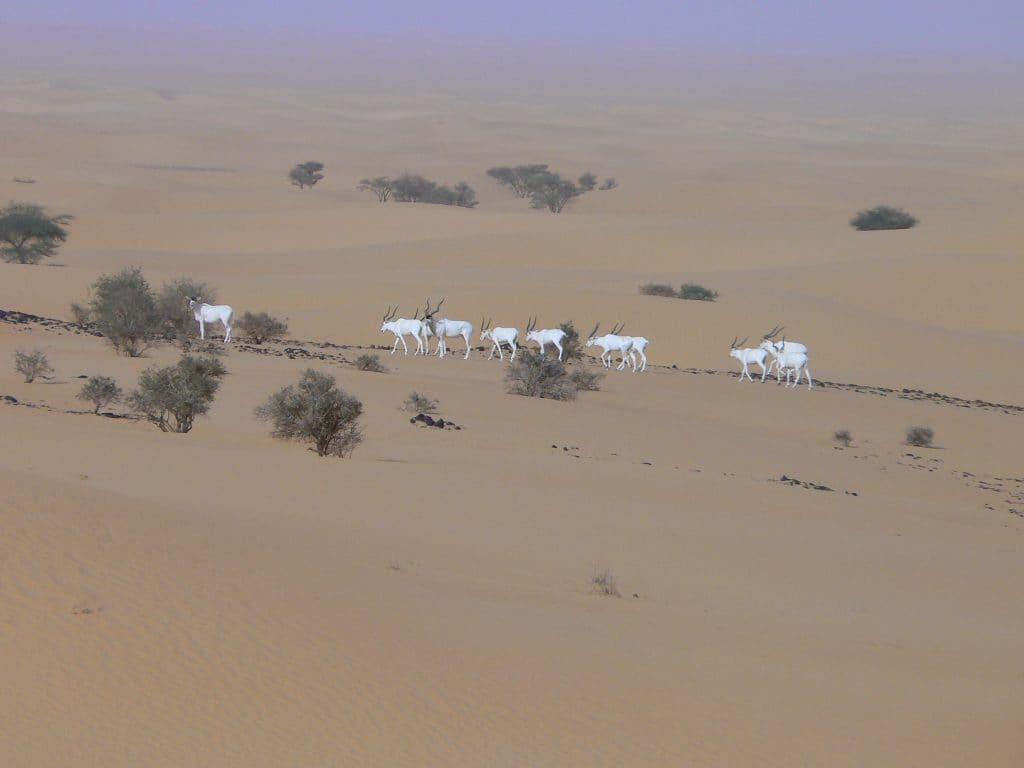Black Gold Or White
In the fall of 2008, Niger began drilling for oil in the Tin Toumma desert to the east of the country. Tin Toumma is where SCF and its partners are working to set up a vast new national nature reserve. It is also home to the world’s last viable population of addax. Will the search for black gold deal the final blow to the survival of this magnificent white antelope? Or can we find a just compromise that allows Niger to benefit from its subterranean riches whilst conserving its precious living natural resources?

This new threat will require enormous effort on all sides to resolve. Not only is there a strong possibility the addax will be hunted but the peace and tranquillity they have enjoyed and require to cope in such a rigorous habitat will be shattered. Enormous trucks are already roaming noisily across the desert and an airstrip and base camps have been established deep in the desert.
The solution lies in constructive engagement between environmental and mining interests, coupled with a mutual desire to see a win-win solution developed. It is possible to have both black gold and white addax but this rosy outcome should not be taken for granted. Niger is determined to get at its oil and as one of the poorest nations on earth this is understandable. A major challenge lies not only with the disturbance caused by oil prospection and extraction but controlling the activities of the military forces put in the field to protect the oil workers. Thanks to the project’s network of community game guards we know already that gazelles have been poached and it is only a matter of time before the addax also come into range.
So, what can be done? SCF’s strategy is based on three interrelated components: dialogue, awareness and action. We must continue playing the role of moderator and catalyst to bring the various stakeholders together to look for mutually beneficial outcomes. To assist in this process we are using tools such as posters, films, lectures and workshops to raise the nation’s awareness of the unique, living wealth of natural resources that Niger’s deserts contain. A major strand of this campaign has been the showing on TV, both at home and throughout the region, of a documentary made by a local cineaste in 2007 with SCF on the ecology of Tin Toumma and the global importance of conserving its unique and rapidly dwindling wildlife. Moves are now afoot to get a fully professional documentary made.
Equally important is the need to demonstrate quite tangibly that Niger’s wildlife is worth saving and one way to do this is by having a strong presence in the field to watch and to dissuade would be miscreants from poaching. Even though the addax is protected by law, poaching will certainly occur unless vigorously controlled. Unfortunately the odds are not in our favour. The desert is vast and the means and manpower at the disposal of the wildlife service limited. But thankfully wildlife protection is not uniquely a question of force but a delicate balance between carrot and stick, where getting people onside is much more likely to have a long-lasting effect than force alone. As Theodore Roosevelt said quoting an African proverb “Speak softly and carry a big stick, and you will go far.” Frankly I doubt it. If there is one thing we have learned about conservation it is big sticks are no guarantee of success. To the contrary they don’t resolve the root causes that often lead to hunting and overuse of wildlife and tend to create enemies rather than friends. As a result we are proactively engaged in working with the military forces and local government to harness their presence in the field to assist in conservation rather than act as agents of its destruction. Slowly, progress is being made to change attitudes. As for the critically endangered addax, let’s sincerely hope when the oil is long gone, the dust and smoke settled and peace has returned they are still out there secure in their desert fastness.
John Newby, CEO Sahara Conservation Fund


Superb post however I was wanting to know if you could write a litte more on this topic? I’d be very grateful if you could elaborate a little bit more.
Pretty! This has been a really wonderful post. Many thanks for providing these details.
very informative articles or reviews at this time.
I like the efforts you have put in this regards for all the great content. Watch bbcpersian
For the reason that the admin of this site is working no uncertainty very quickly it will be renowned due to its quality contents.
Great information shared.. really enjoyed reading this post thank you author for sharing this post .. appreciated
I appreciate you sharing this blog post. Thanks Again. Cool.
For the reason that the admin of this site is working no uncertainty very quickly it will be renowned due to its quality contents.
Hi there to all for the reason that I am genuinely keen of reading this website s post to be updated on a regular basis. It carries pleasant stuff.
Refocus your academic efforts with our ‘pay someone to do my exam’ service. Our team’s expertise is the secret ingredient to effortless top grades. Rely on us for a streamlined route to academic victory, freeing you to excel in all your endeavors.
Amazing blog & phenomenal writting. It was truly informative, thank you for putting all the effort that you did in writting this exceptional blog!
It had few minor flaws according to me but all over it was a magnificent piece of writing. I wish you all the best for your future, may you prosper & be more successful in life.
Your point of view caught my eye and was very interesting. Thanks. I have a question for you. https://www.binance.com/join?ref=WTOZ531Y
Your point of view caught my eye and was very interesting. Thanks. I have a question for you. https://www.binance.com/id/register?ref=P9L9FQKY
When you have doubts about your children’s activities or the safety of their parents, you can hack their Android phones from your computer or mobile device to ensure their safety. No one can monitor around the clock, but there is professional spy software that can secretly monitor the activities of Android phones without making them aware.
Pedicab Tours New York is the best provider of recreational services committed to delivering an unforgettable experience to both visitors and locals in the heart of New York City’s renowned park. With over 11+ years of experience, our company specializes in offering delightful Central Park tours.
very satisfying in terms of information thank you very much.<a href="https://www.images.google.com.ph/url?sa=t
Thanks for sharing. I read many of your blog posts, cool, your blog is very good. https://www.binance.com/es/register?ref=YY80CKRN
Thank you for great article. look forward to the continuation.-vox online stream kostenlos ohne anmeldung
MyCellSpy is a powerful app for remote real – Time monitoring of Android phones.
As I website owner I believe the content material here is really good appreciate it for your efforts.Thermalright Phantom Spirit 120SE ARGB CPU Cooler154mm High with 7 Heat PipesComputer CPU Air Cooler Double Towers
I am a very free online live adult webcams here waiting for your milk
But wanna say that this really is quite helpful Thanks for taking your time to write this. – mens hey dude shoes
Can you be more specific about the content of your article? After reading it, I still have some doubts. Hope you can help me.
Your content is always on point. illplaywithyou
I was wondering if you ever considered changing the page layout of your site? Its very well written; I love what youve got to say. But maybe you could a little more in the way of content so people could connect with it better. Youve got an awful lot of text for only having one or two images. Maybe you could space it out better?
Thanks for sharing. I read many of your blog posts, cool, your blog is very good.
You should take part in a contest for one of the greatest sites on the web. I am going to recommend this website!
Normally I do not read article on blogs, however I wish to say that this write-up very pressured me to take a look at and do so! Your writing taste has been amazed me. Thank you, quite great article.
You’re so awesome! I don’t believe I have read a single thing like that before.
You have a knack for making things clear. hot nude cams
Thank you for sharing! Your post is truly exceptional, providing valuable information at no cost. It’s great to see a blog that values offering quality content for free. Don’t forget to visit us at koruu for more insightful reads.
Thank you for sharing such valuable information! Your blog is truly appreciated for its clear and insightful content. For more valuable insights and information on cnc machining china, be sure to visit our website.
Thank you for your kind words! I’m thrilled that you find the information valuable. If you’re interested in exploring more about aluminum profiles and their manufacturing, feel free to visit my site.
Thank you for sharing such valuable information! Your blog is truly appreciated for its clear and insightful content. Keep up the great work! Don’t forget to check out our Premium Desert Safari experiences for an unforgettable adventure.